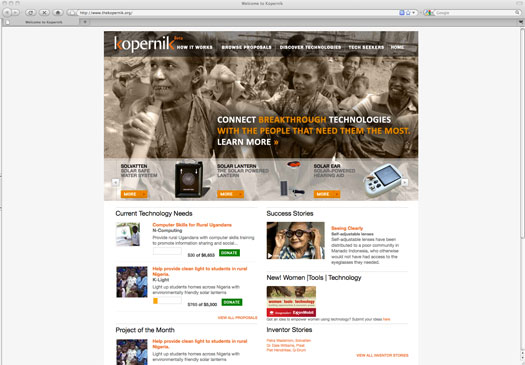
The video clip shows how, with crinkled hands, Salome, a 72-year-old woman living in a remote village in Indonesia, picks up a pair of eyeglasses just given to her. Her face erupts into a wide smile as she blinks curiously through the lenses.
Salome’s failing vision is one of the reasons she rarely leaves her neighborhood, if she ventures from her house at all. She’s not a rarity. Many elderly people living on low incomes in small villages find it impossible to travel to an eye clinic located in a faraway city. The glasses, designed by the Oxford University physicist Joshua Silver, are self-adjustable and address the lack of trained optometrists in the area.
On this day Salome received a visit from Ewa Wojkowska, one of the founders of Kopernik, an online site still in its beta version that aims to connect cutting-edge technology designed for the developing world to the people who need it. Wearers can change the power of the glasses themselves by turning wheels on syringes connected to the frames to pump silicone oil into the lenses, altering their shape.
“We’re really an online store,” says Wojkowska, 34. It’s also the latest in a growing number of online sites that tap into visitors’ interest in helping others fund projects that improve their lives. Kiva distributes microloans to poor people around the world with an entrepreneurial spirit. GlobalGiving allows visitors to contribute to more than 700 grassroots community charity projects worldwide — all with a click of their keyboards.
Kopernik is a riff on those sites’ successful models. Visitors, and would-be investors, select from a menu of new technologies designed to make life better in the developing world. They range from a rollable water container that helps ease the burden of carrying heavy water vessels to a solar-powered LED clean light that can reduce the financial burden on poor families for expensive kerosene to a solar-powered hearing aid.
Local NGOs in needy communities apply to Kopernik in a vetting process for one or more of the technologies. Once approved, the community and the requested aid go live on the site. Visitors can start funding a particular project with as little as $1. Once enough money is raised, Kopernik will place an order with the technology makers, who then ship directly to the NGOs. For their part, communities are required to report feedback, make videos or take photos of how the products are received.
Wojkowska says she and co-founder Toshihiro Nakamura, 35, are interested in making appropriate and useful emerging technologies accessible. “We’re not pushing anything down anyone’s throat. [The NGOs] are coming to the site to look at the range of products on there, so first they’ve got that choice, then they’ve got the voice to tell us what they think about it.”
The pair, who previously worked at the United Nations Development Fund and World Bank, came up with their model last year, after a decade of ruing the slow and often bureaucratic process of getting new technologies to the developing world and being concerned that innovations weren’t accessible to the people they were designed for.
“These local organizations, almost all the time, end up becoming a subcontractor of international NGOs or the U.N. They’re basically told what to do and report back. So we wanted to change that mentality of top-down assistance and empower these local organizations to have more say [in the aid process],” Nakamura says.
The collaboration helps the technology makers as well. They’re often challenged with lack of distribution channels and local community partners. By working with Kopernik, they hope to process more orders and eventually bring down their costs, which can make their products too expensive for government agencies to consider.
So far, Kopernik has distributed several of the products — including solar-powered lanterns, LifeStraws and the the self-adjustable eyeglasses Salome now wears. Nakamura says besides the grant program, they plan to roll out microlending and other services later this year. Now they’re focusing on getting the word out and increasing the number of potential donors to their site.
